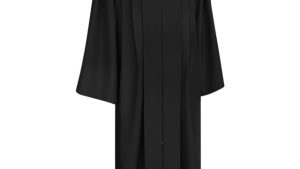
Step into a courtroom, and amidst the hushed tones and authoritative presence, one element stands out as an emblem of justice – the judge’s robe. These garments, steeped in tradition and gravitas, serve as a visual representation of the judiciary’s solemn duty to uphold the law. From the majestic black robes of the United States to the scarlet and ermine-trimmed robes of England, judge robes carry with them a rich history and symbolism that transcends time and borders.
Crafted with care and precision, judge robes are more than mere attire; they are a symbol of impartiality, wisdom, and respect for the rule of law. The elegant draping of the fabric, the dignified cut, and often subtle embellishments all come together to create a visual representation of the values that form the cornerstone of our legal systems. Behind every judge’s robe lies a tradition of honor, fairness, and the weight of judicial responsibility.
History of Judge Robes
In ancient times, judge robes were a reflection of authority and wisdom, signifying the judge’s impartiality and fairness. The tradition of wearing judicial robes can be traced back to the Roman Empire, where judges wore togas as a symbol of their authority and the importance of their role in delivering justice.
As societies evolved, so did judge robes. The influence of the British legal system in the Middle Ages solidified the practice of judges wearing robes in court. The adoption of robes by judges in England spread to other nations and became a standard part of courtroom attire for judges around the world.
judge robes for woman
Today, judge robes continue to play a significant role in the legal system, representing the solemnity and dignity of the judicial process. Modern judge robes are tailored to fit comfortably and are often made from high-quality fabrics, reflecting the professionalism and integrity expected of those who administer justice.
Materials Used in Judge Robes
Judge robes are typically made from high-quality materials designed to convey professionalism and authority. The most common fabrics used in crafting judge robes include wool, polyester, and silk. Wool is favored for its durability and ability to drape elegantly, creating a commanding presence in the courtroom.
Polyester is another popular choice for judge robes due to its affordability and wrinkle-resistant properties. It provides a sleek and polished look, ensuring that judges appear dignified at all times. Additionally, the easy-care nature of polyester makes it a practical option for busy members of the judiciary.
For those seeking a more luxurious option, silk judge robes offer a touch of opulence and sophistication. Silk is prized for its smooth texture and natural sheen, lending an air of distinction to judicial attire. While silk judge robes may require more delicate handling, the luxurious look and feel make them a standout choice for certain ceremonial occasions.
Impact of Judge Robes on Justice System
Judge robes hold significant meaning within the justice system, symbolizing authority, impartiality, and respect. When judges don their robes, they not only embody the essence of their role but also establish a visual representation of fairness and order in the courtroom. The distinctive attire helps to create a sense of seriousness and formality, setting the tone for legal proceedings and signaling the adherence to established legal protocols.
The use of judge robes plays a crucial role in upholding the dignity and decorum of the judiciary. By wearing these traditional garments, judges communicate their commitment to the principles of justice and the rule of law. The robes serve as a reminder that decisions being made are grounded in objectivity and integrity, free from external influences or personal biases. This visual cue reinforces the notion that justice is blind and must be administered without prejudice or favoritism.
Moreover, judge robes serve as a unifying symbol of authority and continuity within the legal system. Regardless of individual preferences or background, all judges wear robes to underscore their shared responsibility in upholding the principles of justice. The consistency in attire also helps to foster public trust in the judiciary by projecting an image of professionalism and reliability. Ultimately, the impact of judge robes on the justice system extends beyond mere aesthetic considerations, serving as a powerful representation of the enduring values and principles that underpin the rule of law.
















